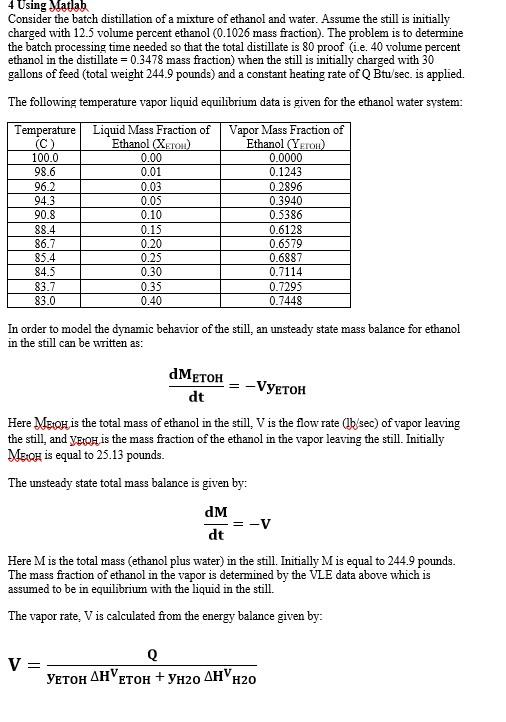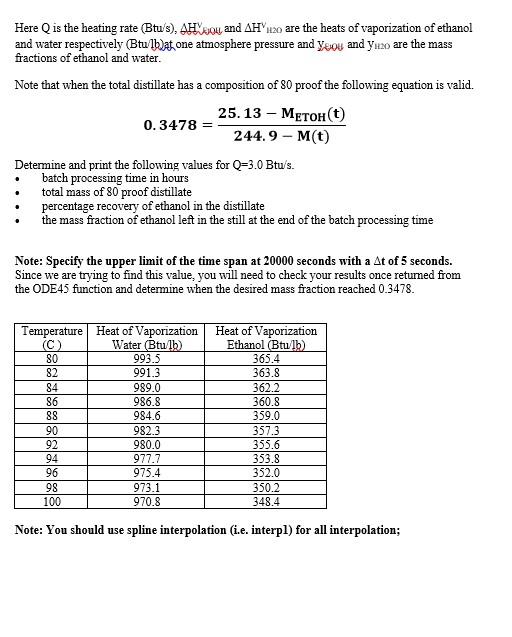

4 Using Matlab Consider the batch distillation of a mixture of ethanol and water. Assume the still is initially charged with 12.5 volume percent ethanol (0.1026 mass fraction). The problem is to determine the batch processing time needed so that the total distillate is 80 proof (i.e. 40 volume percent ethanol in the distillate = 0.3478 mass fraction) when the still is initially charged with 30 gallons of feed (total weight 244.9 pounds) and a constant heating rate of Q Btu/sec. is applied. The following temperature vapor liquid equilibrium data is given for the ethanol water system: (c) Temperature Liquid Mass Fraction of Ethanol (XERON) 100.0 0.00 98.6 0.01 96.2 0.03 94.3 0.05 90.8 0.10 88.4 0.15 86.7 0.20 85.4 0.25 84.5 0.30 83.7 0.35 83.0 0.40 Vapor Mass Fraction of Ethanol (Yero) 0.0000 0.1243 0.2896 0.3940 0.5386 0.6128 0.6579 0.6887 0.7114 0.7295 0.7448 In order to model the dynamic behavior of the still, an unsteady state mass balance for ethanol in the still can be written as: METOH Vy dt Here Match is the total mass of ethanol in the still. V is the flow rate (lb'sec) of vapor leaving the still, and YEtoh is the mass fraction of the ethanol in the vapor leaving the still. Initially ME:QH is equal to 25.13 pounds. The unsteady state total mass balance is given by: dM dt Here M is the total mass (ethanol plus water) in the still. Initially M is equal to 244.9 pounds. The mass fraction of ethanol in the vapor is determined by the VLE data above which is assumed to be in equilibrium with the liquid in the still The vapor rate. V is calculated from the energy balance given by: V Q YETOH AHVETOH + y 20 AHVH20 Here Q is the heating rate (Btus), AH 2004 and AH' 120 are the heats of vaporization of ethanol and water respectively (Btulbat one atmosphere pressure and yeou and yuzo are the mass fractions of ethanol and water. Note that when the total distillate has a composition of 80 proof the following equation is valid. 25.13 - Metoh(t) 0.3478 244.9 - M(t) Determine and print the following values for Q=3.0 Btu's. batch processing time in hours total mass of 80 proof distillate percentage recovery of ethanol in the distillate the mass fraction of ethanol left in the still at the end of the batch processing time . Note: Specify the upper limit of the time span at 20000 seconds with a At of 5 seconds. Since we are trying to find this value, you will need to check your results once returned from the ODE 45 function and determine when the desired mass fraction reached 0.3478. Temperature Heat of Vaporization Heat of Vaporization (C) Water (Btulb) Ethanol (Btulb) 80 993.5 365.4 82 991.3 363.8 84 989.0 362.2 86 986.8 360.8 88 984.6 359.0 90 982.3 357.3 92 980.0 355.6 94 977.7 353.8 96 975.4 352.0 98 973.1 350.2 100 970.8 348.4 Note: You should use spline interpolation (i.e. interpl) for all interpolation; 4 Using Matlab Consider the batch distillation of a mixture of ethanol and water. Assume the still is initially charged with 12.5 volume percent ethanol (0.1026 mass fraction). The problem is to determine the batch processing time needed so that the total distillate is 80 proof (i.e. 40 volume percent ethanol in the distillate = 0.3478 mass fraction) when the still is initially charged with 30 gallons of feed (total weight 244.9 pounds) and a constant heating rate of Q Btu/sec. is applied. The following temperature vapor liquid equilibrium data is given for the ethanol water system: (c) Temperature Liquid Mass Fraction of Ethanol (XERON) 100.0 0.00 98.6 0.01 96.2 0.03 94.3 0.05 90.8 0.10 88.4 0.15 86.7 0.20 85.4 0.25 84.5 0.30 83.7 0.35 83.0 0.40 Vapor Mass Fraction of Ethanol (Yero) 0.0000 0.1243 0.2896 0.3940 0.5386 0.6128 0.6579 0.6887 0.7114 0.7295 0.7448 In order to model the dynamic behavior of the still, an unsteady state mass balance for ethanol in the still can be written as: METOH Vy dt Here Match is the total mass of ethanol in the still. V is the flow rate (lb'sec) of vapor leaving the still, and YEtoh is the mass fraction of the ethanol in the vapor leaving the still. Initially ME:QH is equal to 25.13 pounds. The unsteady state total mass balance is given by: dM dt Here M is the total mass (ethanol plus water) in the still. Initially M is equal to 244.9 pounds. The mass fraction of ethanol in the vapor is determined by the VLE data above which is assumed to be in equilibrium with the liquid in the still The vapor rate. V is calculated from the energy balance given by: V Q YETOH AHVETOH + y 20 AHVH20 Here Q is the heating rate (Btus), AH 2004 and AH' 120 are the heats of vaporization of ethanol and water respectively (Btulbat one atmosphere pressure and yeou and yuzo are the mass fractions of ethanol and water. Note that when the total distillate has a composition of 80 proof the following equation is valid. 25.13 - Metoh(t) 0.3478 244.9 - M(t) Determine and print the following values for Q=3.0 Btu's. batch processing time in hours total mass of 80 proof distillate percentage recovery of ethanol in the distillate the mass fraction of ethanol left in the still at the end of the batch processing time . Note: Specify the upper limit of the time span at 20000 seconds with a At of 5 seconds. Since we are trying to find this value, you will need to check your results once returned from the ODE 45 function and determine when the desired mass fraction reached 0.3478. Temperature Heat of Vaporization Heat of Vaporization (C) Water (Btulb) Ethanol (Btulb) 80 993.5 365.4 82 991.3 363.8 84 989.0 362.2 86 986.8 360.8 88 984.6 359.0 90 982.3 357.3 92 980.0 355.6 94 977.7 353.8 96 975.4 352.0 98 973.1 350.2 100 970.8 348.4 Note: You should use spline interpolation (i.e. interpl) for all interpolation








